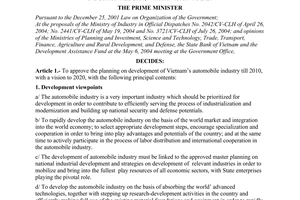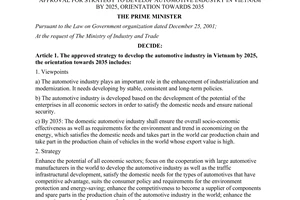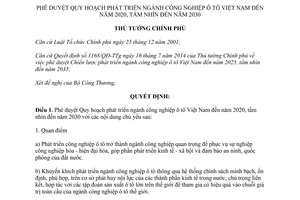Decision No. 1211/QD-TTg 2014 approval development planning of Vietnam automobile industry 2020 2030 đã được thay thế bởi Resolution 63/NQ-CP 2019 list of plannings for investment in specific goods services to be abrogated và được áp dụng kể từ ngày 26/08/2019.
Nội dung toàn văn Decision No. 1211/QD-TTg 2014 approval development planning of Vietnam automobile industry 2020 2030
|
PRIME MINISTER |
SOCIALIST
REPUBLIC OF VIETNAM |
|
No.: 1211/QD-TTg |
Hanoi, July 24, 2014 |
DECISION
APPROVAL FOR DEVELOPMENT PLANNING OF VIETNAM AUTOMOBILE INDUSTRY BY 2020 WITH A VISION TO 2030
PRIME MINISTER
Pursuant to the Law on organization of Government dated December 25, 2001;
Pursuant to Decision No. 1168/QD-TTg dated July 16, 2014 of the Prime Minister on approving the development strategy of Vietnam automobile industry by 2025 with a vision to 2035;
Considering the proposal of the Ministry of Industry and Trade;
DECIDES:
Article 1. Approving the development Planning of Vietnam automobile industry by 2020 with a vision to 2030 with the important contents as follows:
1. Point of view
a) Developing the automobile industry into the important industry for the industrialization and modernization, contributing to the social and economic development and ensuring the security and national defense of the country.
b) Encouraging the development of automobile industry through the transparent, stable and appropriate policy system on the basis of increasing the internal strength of economic sectors in the country; focusing on association and cooperation with large automobile manufacturers in the world in order to effectively participate in the global value chain of the automotive industry in the world.
c) Developing the automobile industry in sync with the development of transport infrastructure, consumption policy, environmental requirements and trends in thrifty use of energy.
2. Objectives
a) General objectives
Developing the Vietnam automobile industry into the important industry of the country, maximum meeting the domestic market demand for types of truck, passenger cars and special-use vehicles; striving to become the supplier of spare parts and components and a number of machine assemblies of high value in the automobile industrial manufacturing chain in the world, contributing to the economic development and boosting the development of other industries.
b) Targets
- Estimated proportion of the number of vehicles locally assembled and manufactured compared with the total domestic demand (%):
|
|
Year 2020 |
Year 2025 |
Year 2030 |
|
Cars with up to 9 seats |
60 |
65 |
70 |
|
Cars with ≥ 10 seats |
90 |
92 |
92 |
|
Trucks |
78 |
78 |
80 |
|
Special-use vehicles |
15 |
18 |
20 |
- Expected automobile output and growth of the years:
|
|
Output of automobiles locally manufactured |
Growth (%/year) |
||||
|
2020 |
2025 |
2030 |
To 2015 |
2016-2020 |
2021-2030 |
|
|
Total |
227,496 |
466,375 |
862,761 |
7.10 |
16.82 |
14.26 |
|
Cars with up to 9 seats |
114,053 |
237,900 |
451,512 |
6.51 |
16.00 |
14.75 |
|
Cars with ≥ 10 seats |
14,154 |
29,102 |
51,288 |
8.18 |
18.00 |
13.74 |
|
Trucks |
97,952 |
197,017 |
356,115 |
7.63 |
17.61 |
13.78 |
|
Special-use vehicles |
1,336 |
2,356 |
3,846 |
10.13 |
19.29 |
11.15 |
- Expected export of CBU automobiles and spare parts:
|
Target |
Calculation unit |
Year 2020 |
Year 2030 |
|
Total amount of exported automobiles |
Unit |
20,000 |
60,000 |
|
In which: Cars with up to 9 seats |
Unit |
5,000 |
30,000 |
|
Cars with > 9 seats |
Unit |
5,000 |
10,000 |
|
Trucks |
Unit |
10,000 |
20,000 |
|
Export of spare parts and components |
Million USD |
4,000 |
6,000 |
- Supporting industry:
+ Period to 2020, basically forming the supporting industry for automobile manufacturing. Striving to meet 30-40% (about the value) of demand for spare parts and components for domestic manufacturing and assembly of automobile, fabrication of important parts in actuator, gearbox and engine (especially for passenger cars and light trucks), gradually involved in the supply system of components and spare parts in the global value chain of the automobile industry in the world.
+ Period 2021 – 2025, further developing the supporting industry for automobile manufacturing, ensuring the supply 40-45% (about the value) of demand for spare parts and components for domestic manufacturing and assembly of automobile while boosting the export and further involved in the global value chain of the automobile industry in the region and the world.
+ Period 2026 – 2030, the supporting industry shall develop in both scale of output and product categories, ensuring the supply of more than 50% (about the value) of demand for spare parts and components for domestic manufacturing and assembly of automobile, striving to become an important supplier of a number of components and spare parts for the automobile industry in the region and the world.
|
|
Percentage of domestic manufacturing value % |
||
|
2020 |
2025 |
2030 |
|
|
Cars with up to 9 seats |
30 - 40 |
40 - 45 |
50 - 55 |
|
Cars with 9 seats or more |
35 - 45 |
50 - 60 |
70 - 75 |
|
Trucks |
30 - 40 |
45 - 55 |
65 - 70 |
|
Special-use vehicles |
25 - 35 |
40 - 45 |
55 - 60 |
3. Development orientation
a) For trucks and passenger cars with 10 seats or more
- Focusing on development of small and multi-purpose trucks for agricultural and rural production.
- Focusing on development of medium and short range passenger cars running between provinces, districts and inner cities…in accordance with the topographical conditions and traffic infrastructure in the country with rational price, safety and convenience.
- Focusing on investment in renovation and upgrade technology to raise the product quality and improve the sale service system, raise the competitiveness and meet the majority of domestic demand and gradually participate in export.
b) For cars with up to 9 seats
- Focusing on consumption orientation to the small-sized personal cars with little fuel consumption consistent with the population’s income and response capability of the traffic infrastructure.
- Identifying the strategic partner, encouraging investment in projects large enough to form market for the supporting industry. Encouraging the manufacturing the environmentally friendly car line (fuel-saving vehicles, hybrid vehicles, biofuel-consuming vehicles, electric vehicles…);
c) For special-use vehicles
- Selecting the manufacturing and assembly of a number of types of vehicle of high demand for domestic market (concrete trucks, tank trucks, special-use vehicles for security and national defense…).
- Encouraging the manufacturing of small and multi-purpose agricultural vehicles (combined with goods transportation with one or many features such as soil preparation, water pumping, generation, pesticide spraying…) to meet the consumers’ demand in rural and mountainous areas.
d) For the supporting industry
- Strengthening the cooperation between domestic enterprises and big automobile firms in manufacturing and fabrication of spare parts and components for assembly of finished vehicles proceeding to manufacturing for export. Particularly, priority is given to the fabrication of important parts and components such as actuator, gearbox and engine, hull…
- Forming a number of concentrated centers/associated clusters of automobile industry on the basis of re-organization and re-arrangement of manufacturing. Boosting the cooperation and association between automobile assembly and manufacturing enterprises, supporting industry enterprises, development research establishments and training establishments of all economic sectors to raise the investment performance and enhanced specialization.
d) Other strategic orientation
- Developing and expanding the automobile and mechanical industrial parks in three key economic areas: Northern key economic area, Central key economic area and Southern key economic area with the size of 200-1,000 ha, prioritizing the manufacturing projects with large scale and the supporting industry for automobile manufacturing industry.
- Preparing the list of projects prioritized for calling for and attracting investment, especially the projects with incentive investment in the field of environmentally-friendly automobile manufacturing (fuel-saving vehicles, hybrid vehicles, biofuel-consuming vehicles, electric vehicles…).
4. Investment capital
- Capital is mobilized from foreign investors;
- Capital of enterprises.
- Capital from budget partially supporting the investment in infrastructure, reseach and development and training of human resources;
- Other sources of capital
5. Solutions and policy mechanisms
a) Policy on manufacturing area
- Applying the import tax rate ceiling to the tariff commitments that Vietnam has participated for spare parts and components which need the incentive investment and manufacturing and the spare parts, components domestically manufactured which meet the requirements for quality and number.
- Adding the project of manufacturing of small and multi-purpose agricultural vehicles in the List of investment projects entitled to the supporting policies to minimize agricultural losses.
- Project of manufacturing of environmentally friendly vehicles (fuel-saving vehicles, hybrid vehicles, biofuel-consuming vehicles, electric vehicles…) is entitled to the current highest incentive policies;
- Encouraging domestic enterprises to participate in the global supply chain in manufacturing and export of spare parts and CBU vehicles by the following measures:
+ Application of stable export credit policy under the current regulations of the State.
+ Entitled to incentive benefits of the national commercial promotion Program.
+ Entitled to current incentives under the key mechanical Program.
- Project of manufacturing of spare parts and components which is entitled to the loan of credit capital for investment and development with the lowest interest for each period.
- Enterprises manufacturing automobile spare parts and components are entitled to the incentives under the Plan “Assistance in development of small and medium-sized enterprises in the field of supporting industry” of the Government;
b) Policies on consumption sector
- Implementing the road map of reduction in import tax of CUB automobiles in ATIGA (ASEAN) by the end of 2018 as committed by the Government of Vietnam.
- Reviewing and adjusting the tax and fee policies towards facilitating the development of the automotive industry to meet the demand for car use of the economy and the people, in sync with the development of transport infrastructure and environmental protection requirements.
- For special consumption tax applied to passenger vehicles with < 24 seats: tax rate adjustments applied with category and utility of vehicles:
+ Applying the lowest tax rate to medium and short range passenger cars running between provinces, districts and inner cities…from 16 to < 24 seats and types of vehicle transporting both passengers and goods for agricultural and rural purposes.
+ Applying the incentive tax rate to environmentally friendly vehicles.
+ Applying the high tax rate to the passenger cars with up to 9 seats with engine capacity of over 3.0 litres.
- Adding light trucks with maximum load up to 3 tons and small and multi-purpose agricultural vehicles to the list of machine and equipment entitled to the assistance under the guidelines of the Government on assistance policies to minimize agricultural losses.
e) Other measures and policies
- Uniformly complying with the policy system which has been issued/will be issued in at least 10 years consistent with the trend of integration in order to give confidence to investors, manufacturers, increase the attraction of investment activities investments to achieve the development objectives of automotive industry.
- Improving and adding the technical standards to the automobiles domestically manufactured to protect the consumers consistent with the international practices.
- Issuing the high environmental fees to the vehicles with engine capacity of over 3.0 litres.
- Adding the regulations and standards on importing agents (financial capacity, storage, warranty and maintenance..).
- The State shall provide partial assistance from the budget capital for the research – development and training to improve the specialized engineers;
Article 2. Implementation organization
1. Ministry of Industry and Trade
- Publicizing and directing the implementation of planning; reviewing, updating and requesting the Prime Minister to consider and make decision on the adjustment and addition of planning.
- Coordinating with the Ministry of Finance to review, aggregate and propose the policies on incentive credit, tax and fees in order to boost the manufacturing and market development while taking the most of opportunities during the integration to meet the development targets of automobile industry for submission to the Prime Minister for consideration and decision under the assigned tasks in the approved strategy.
- Issuing specific regulations to ensure the manufacturing and import of engine, motor vehicles and supply fuel used for motor vehicles with the quality in accordance with the national technical regulations and the road map approved by the Prime Minister.
- Strengthening the management of market and import and export activities of engine, automobiles, prevention of smuggling and commercial fraud.
2. Ministry of Finance
- Coordinating with the Ministry of Industry and Trade and the Ministries and sectors concerned to develop the formula to determine the price for calculation of special consumption tax to ensure the equality between the automobiles domestically manufactured and the CBU automobiles of the same type.
- Closely controlling the tax collection over automobiles, spare parts and components imported; coordinating with the Ministries concerned to strengthening the measures to prevent smuggling and commercial fraud.
3. Ministry of Science and Technology
- Coordinating with the Ministries and sectors concerned to issue the technical normative standards to the automobiles domestically manufactured in accordance with international standard; developing and issuing the technical standards to the imported automobiles.
- Promptly developing, issuing and publicizing the national technical regulations on gasoline, diesel fuel and biofuel with the gas emission standard in accordance with the road map of application of approved exhaut emission standard.
- Coordinating with the Ministries and sectors concerned to develop and issue the guidelines and regulations on technological transfer for the manufacturing and assembly of automobiles and spare parts;
- Coordinating with the Ministry of Industry and Trade to study and propose the addition of automobile products and components to the List of high-tech products which are encouraged for development for submission to the Prime Minister.
4. Ministry of Transport
- Coordinating with the Ministries and sectors concerned to issue the technical regulation and quality standard to the automobiles domestically manufactured;
- Enhancing the inspection and control of exhaut gas from the motor vehicles domestically manufactured and imported and the vehicles in circulation to ensure the satisfaction of regulations on exhaut gas; decisively stopping the operation of vehicles in circulation which do not satisfy the regulations on exhaut gas standard.
5. Ministry of Planning and Investment
Coordinating with the Ministry of Industry and Trade and other organs concerned during the development and expansion of industrial parks of mechanics and automobile in economic zones;
6. Ministry of Agriculture and Rural Development
Coordinating with the Ministry of Industry and Trade to request the Government to add the type of light truck with the maximum load of 3 tons and the small and multi purpose agricultural vehicles to the List of machinery and equipment; add the project of manufacturing of small and multi purpose agricultural vehicles to the List of investment projects under the guidelines of the Government on the assistance policies to minimize the agricultural losses;
7. People's Committees of provinces and centrally-run cities; Vietnam Engineering Business Association; Vietnam Automobile Manufacturer Association and Vietnam Society of Automotive Engineers:
Participating in and closely coordinating under the functions and duties of each organ in implementation of planning to ensure the consistency and uniformity.
Article 3. This Decision takes effect from the date of its signing and supersedes Decision No. 177/2004/QD-TTg October 05, 2004 of the Prime Minister approving the development Planning of Vietnam
Article 4. Ministers, heads of ministerial-level organs, heads of government agencies, Chairman of People's Committees of provinces and centrally-run cities and the heads of the agencies concerned are responsible for implementing this Decision. /.
|
|
PRIME MINISTER |
------------------------------------------------------------------------------------------------------
This translation is made by LawSoft and
for reference purposes only. Its copyright is owned by LawSoft
and protected under Clause 2, Article 14 of the Law on Intellectual Property.Your comments are always welcomed




